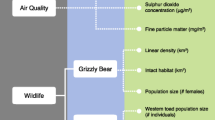Abstract
The cross-impact assessment process (CAP) is presented as a practical method for efficiently identifying a parsimonious set of critically important variables and associated relationships needed to conduct environmental impact studies. CAP was developed from the logic of a number of techniques that are collectively referred to as cross-impact analysis. The process is based on a series of structured workshops. The participants represent a variety of disciplines and individual members are selected because they have both the depth of understanding necessary to contribute specific knowledge on the environmental impact assessment problem and the breadth of view to integrate that knowledge with the information provided by other panelists. The results of the workshops are summarized in an importance index and presented in a cross-impact matrix. CAP is illustrated with an example from an Upper Mississippi River recreation impact study, but it can also be applied to any environmental impact assessment problem that can be characterized as a system of variables and relationships. CAP also provides an efficient and reasonably objective means for assigning priorities to environmental impact studies.
Similar content being viewed by others
Literature cited
Bisset, R. 1978. Quantification, decision-making and environmental impact assessment in the United Kingdom. J. Environ. Manage. 7:43–58.
Bonnicksen, T. M. 1981. Brushland fire-management policies: A cross-impact simulation of southern California. Environ. Manage. 5(6):521–529.
Bonnicksen, T. M., and R. G. Lee. 1982. Biosocial systems analysis: An approach for assessing the consequences of resource policies. J. Environ. Manage. 15(1):47–61.
Bonnicksen, T. M., and R. G. Lee. 1979. Persistence of the fire exclusion policy in southern California: a biosocial interpretation. J. Environ. Manage. 8(3):277–293.
Davos, C. A. 1977. Towards an integrated environmental assessment within a social context. J. Environ. Manage. 5:297–305.
Dooley, J. E. 1979. A framework for environmental impact identification. J. Environ. Manage. 9:279–287.
Kane, J. 1972. A primer for a new cross-impact language-KSIM. Technol. Forecast. Soc. Change 4:129–142.
Kane, J., I. Vertinsky, and W. A. Thompson. 1973. KSIM: A methodology for interactive resource policy simulation. Water Resour. Res. 9:65–79.
Knetsch, J. L. 1979. Environmental and economic assessments in development project planning. J. Environ. Manage. 9:237–246.
Leopold, L. B., F. E. Clarke, B. B. Hanshaw, and J. R. Balsley. 1971. A procedure for evaluating environmental impact. Geololgical Survey Circular 645, US Department of the Interior. 13 pp.
Nunnally, J. C. 1978. Psychometric theory. McGraw-Hill, New York, NY.
Smith, J. B. and P. G. Kruzic. 1976. Analyzing future business environments. Stanford Research Institute Business Intelligence Program, Research Report No. 585.20 pp.
Scheidel, T. M., and L. Crowell. 1979. Discussing and deciding. MacMillan Publishing Co., Inc., New York, NY. 331 pp.
Stephenson, W. 1953. The study of behavior. University of Chicago Press, Chicago, IL.
Teller, H. L. 1977. Environmental impact analysis and forestry activities. FAO Conservation Guide 1. Guidelines for Watershed Management. Food and Agricultural Organization of the United Nations, Rome. Pages 15–25.
The Recreation Research Consortium. 1981. Evaluation of impacts of navigation and associated operation and maintenance procedures on recreation, potential wilderness and cultural resources of the Upper Mississippi River Basin. Final report to the Upper Mississippi River Basin Commission. 320 pp.
Thor, E. C., G. H. Elsner, M. R. Travis, and K. M. O'Loughlin. 1978. Forest environmental impact analysis—a new approach. J. For. 76:723–725.
Author information
Authors and Affiliations
Rights and permissions
About this article
Cite this article
Bonnicksen, T.M., Becker, R.H. Environmental impact studies: An interdisciplinary approach for assigning priorities. Environmental Management 7, 109–117 (1983). https://doi.org/10.1007/BF01867271
Issue Date:
DOI: https://doi.org/10.1007/BF01867271




